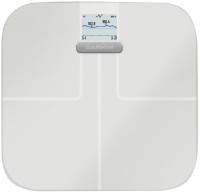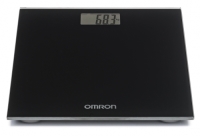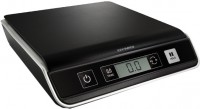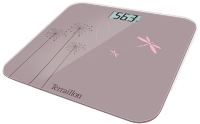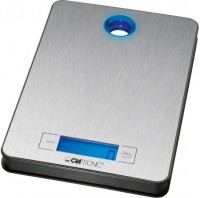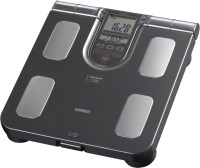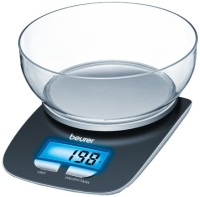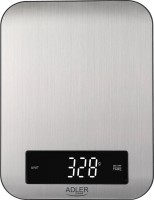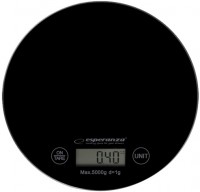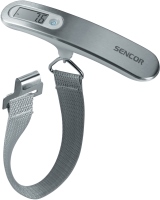Scales Medisana
All Scales Advanced filters → |
You might be interested in
Articles, reviews, useful tips
All materials
What to give a cook lover?
Practical gift options for talented cooks

What to give a friend?
We have selected different gift options for a girl that will suit those who love cooking, self-care and so on
Scales: specifications, types
Scales type
— Floor. Scales designed primarily to measure the weight of the human body. According to the name, they are designed for installation on the floor. Advanced models, in addition to the actual mass, can also measure and calculate a number of additional diagnostic parameters: height, percentage of water content in the body, fat/bone tissue, body mass index, etc. (see below for more details).
— Kitchen. Scales intended pri...marily for measuring the weight of foodstuffs; they are indispensable if you prefer to cook exactly according to recipes, or are engaged in dishes that require precise proportions. Additional functions of such scales mainly include tare compensation.
— Pocket. Pocket scales, recognized for their small size and specific design, typically feature an elongated body with a central element for hanging loads, such as a hook or loop. This construction enables the scales to be suspended from the load, akin to holding a handle, and determines mass based on the force exerted on the suspension. Despite their compactness, which lends itself to easy portability (hence the name "pocket scales"), these devices can deliver notable accuracy, with divisions ranging from 10 to 100 grams. Their maximum weight capacity (refer to "Measurement weight" below) can extend up to 50 kg, often sufficient for most handheld loads. Pocket scales prove advantageous in various scenarios, including purchasing large quantities of produce or bulk items, weighing luggage before air travel, and more.
— Baby scales, designed for weighing newborns and young children who are not yet able to stand on their feet. The platform of such scales is a tray with characteristic sides, in which you can put the baby on his back without fear that he will slip off the scales (although leaving the child unattended on such a surface is still not worth it). The maximum weight of measurements in such devices is about 10 – 20 kg — this is more than enough for their main purpose.
— Spoon-scales. A kitchen gadget called a "spoon scale" seamlessly integrates a spoon and a scale. Essentially, it's a measuring spoon with a built-in scale display and weighing mechanism within the handle. This tool offers evident convenience, allowing users not only to estimate liquids or bulk items visually but also to instantly ascertain their precise weight. This proves especially useful when meticulous ingredient measurement is necessary, particularly in complex recipe preparations.
— Kitchen. Scales intended pri...marily for measuring the weight of foodstuffs; they are indispensable if you prefer to cook exactly according to recipes, or are engaged in dishes that require precise proportions. Additional functions of such scales mainly include tare compensation.
— Pocket. Pocket scales, recognized for their small size and specific design, typically feature an elongated body with a central element for hanging loads, such as a hook or loop. This construction enables the scales to be suspended from the load, akin to holding a handle, and determines mass based on the force exerted on the suspension. Despite their compactness, which lends itself to easy portability (hence the name "pocket scales"), these devices can deliver notable accuracy, with divisions ranging from 10 to 100 grams. Their maximum weight capacity (refer to "Measurement weight" below) can extend up to 50 kg, often sufficient for most handheld loads. Pocket scales prove advantageous in various scenarios, including purchasing large quantities of produce or bulk items, weighing luggage before air travel, and more.
— Baby scales, designed for weighing newborns and young children who are not yet able to stand on their feet. The platform of such scales is a tray with characteristic sides, in which you can put the baby on his back without fear that he will slip off the scales (although leaving the child unattended on such a surface is still not worth it). The maximum weight of measurements in such devices is about 10 – 20 kg — this is more than enough for their main purpose.
— Spoon-scales. A kitchen gadget called a "spoon scale" seamlessly integrates a spoon and a scale. Essentially, it's a measuring spoon with a built-in scale display and weighing mechanism within the handle. This tool offers evident convenience, allowing users not only to estimate liquids or bulk items visually but also to instantly ascertain their precise weight. This proves especially useful when meticulous ingredient measurement is necessary, particularly in complex recipe preparations.
Mechanism
— Mechanical. One of the simplest weighing systems, known for a long time and has not lost popularity to this day. Typically operating on the spring principle, this design features a scale platform that compresses a spring as weight is applied (with greater weight resulting in stronger compression). An attached arrow displays measurement outcomes on the scale. Mechanical models boast simplicity, affordability, and independence from power sources, rendering batteries or outlets unnecessary. Howev...er, achieving high measurement precision proves challenging in such devices; even the most precise kitchen models offer divisions of around 10 grams. Furthermore, additional features such as voice notification are not feasible for mechanical scales. As a result, this design is predominantly found in budget-friendly floor and kitchen scales intended for simple use.
— Electronic. These weighing systems are founded on electronic pressure sensors (such as magnetic or pneumatic sensors) along with specialized circuits responsible for data processing and display. Compared to mechanical scales, electronic scales are notably more complex and expensive. They require a regular supply of batteries or recharging, depending on the model. However, electronic scales excel over mechanical counterparts in terms of accuracy, functionality, and overall user convenience. While mechanical scales with arrows need to be read from a strictly perpendicular angle to avoid misinterpretation, electronic scales display their readings without such difficulties. Additional features are extensively covered in the "Functions" section, with many of these functions being exclusive to electronic scales. Notably, electronic scales are the preferred choice for accuracy-sensitive tasks, such as jewelry weighing, where measurements extend to tenths and hundredths of a gram (for more details, see "Type of scales").
— Electronic. These weighing systems are founded on electronic pressure sensors (such as magnetic or pneumatic sensors) along with specialized circuits responsible for data processing and display. Compared to mechanical scales, electronic scales are notably more complex and expensive. They require a regular supply of batteries or recharging, depending on the model. However, electronic scales excel over mechanical counterparts in terms of accuracy, functionality, and overall user convenience. While mechanical scales with arrows need to be read from a strictly perpendicular angle to avoid misinterpretation, electronic scales display their readings without such difficulties. Additional features are extensively covered in the "Functions" section, with many of these functions being exclusive to electronic scales. Notably, electronic scales are the preferred choice for accuracy-sensitive tasks, such as jewelry weighing, where measurements extend to tenths and hundredths of a gram (for more details, see "Type of scales").
Minimum measurement weight
The minimum weight limit at which the scale's readings must align with the specified margin of error is referred to as the minimum load parameter. While theoretically the scale can display measurements below this threshold, the reliability of results can't be guaranteed due to the extremely low load on the sensors in the device's design. The minimum load requirement is primarily determined by the type and intended use of the scales. For instance, kitchen models typically have a range...of a few grams, floor scales start at a couple of kilograms, and commodity warehouse scales might begin at 10-15 kg.
Max. measurement weight
The largest weight that is allowed to be placed on the platform of this scale model. If this parameter is exceeded, the scales, at best, will not be able to show the correct data, at worst, they will completely fail. Obviously, the maximum weight is directly related to the purpose, but even kitchen scales can weigh both up to 5 kg and up to 20 kg.
Actually, floor scales have the largest maximum measurement weight, in such models it can reach ..."/list/282/pr-17693/">200 kg or even more. And the most delicate are jewelry models (refer to "Type"). Also note that in mechanical devices (refer to "Mechanism") the scale is usually graduated to the maximum weight.
Now on the market there are scales with such a maximum weight: up to 1 kg, up to 5 kg, up to 10 kg, up to 50 kg, up to 150 kg, up to 200 kg.
Actually, floor scales have the largest maximum measurement weight, in such models it can reach ..."/list/282/pr-17693/">200 kg or even more. And the most delicate are jewelry models (refer to "Type"). Also note that in mechanical devices (refer to "Mechanism") the scale is usually graduated to the maximum weight.
Now on the market there are scales with such a maximum weight: up to 1 kg, up to 5 kg, up to 10 kg, up to 50 kg, up to 150 kg, up to 200 kg.
Scale division
Scale division value. Initially, the term "scale division" referred only to mechanical devices (see "Mechanism") and meant the distance between divisions on a scale; however, out of habit, they began to use it for electronic scales. Moreover, both there and there the meaning of this parameter is the same — in fact, it directly describes the accuracy of measurements. For example, if the division value is 1 g, the weight on such devices can be measured with an acc...uracy of 1 g, regardless of whether it is a mechanical model or an electronic one.
Theoretically, the lower the division value, the more accurate the measurements and the more advanced the device is. On the other hand, high accuracy has a corresponding effect on the price, although in some situations it is not required in principle. So when choosing it is worth considering the features of the application of the device. For example, a kitchen scale with a division value of 0.5 – 1 g will be indispensable for a sophisticated cooker who cooks according to complex recipes with an abundance of ingredients in a small dosage; and for ordinary household cooking on a large scale, an accuracy of 10–20 g is quite enough. But there are also cases when, over the entire measurement range, the division value changes. So for more correct measurements (low weight), the accuracy can be measured in units of grams, for average values — in tens of grams, and already for heavyweights, where an error of 50 – 100 grams is not so critical, even in hundreds of grams. In such cases, we have a value for the general average range in the catalog (if we take into account the floor, then this is approximately for a person of 70 kg).
Theoretically, the lower the division value, the more accurate the measurements and the more advanced the device is. On the other hand, high accuracy has a corresponding effect on the price, although in some situations it is not required in principle. So when choosing it is worth considering the features of the application of the device. For example, a kitchen scale with a division value of 0.5 – 1 g will be indispensable for a sophisticated cooker who cooks according to complex recipes with an abundance of ingredients in a small dosage; and for ordinary household cooking on a large scale, an accuracy of 10–20 g is quite enough. But there are also cases when, over the entire measurement range, the division value changes. So for more correct measurements (low weight), the accuracy can be measured in units of grams, for average values — in tens of grams, and already for heavyweights, where an error of 50 – 100 grams is not so critical, even in hundreds of grams. In such cases, we have a value for the general average range in the catalog (if we take into account the floor, then this is approximately for a person of 70 kg).
Units of measurement
Weights are able to keep records in various units of measurement, while accounting can be done both by mass and by volume. Among the most common units of measurement, we highlight the following.
— Grams (g) — a unit of weight that belongs to the metric system. Grams are used in desktop kitchen scales.
— Kilograms (kg) — a unit of weight that belongs to the metric system. Kilograms are used in floor weighing equipment.
— Pounds (lb:oz) is a common unit of weight used in...some countries in Europe, as well as in the United States. 1 pound can be equated to 0.45 kilograms.
— Milliliters (ml) — a unit of volume that belongs to the metric system. Some models of scales are able to determine the volume of milk and water based on mass.
— Ounces (fl'oz) is a unit of volume used in English-speaking countries. 1 US ounce is equivalent to 30 mL.
— Stones (st) is the British unit of weight. Stones are used to take into account the mass of the human body, so this measurement system is found in floor household and specialized diagnostic scales. 1 stone can be equated to 6.35 kilograms.
— Grams (g) — a unit of weight that belongs to the metric system. Grams are used in desktop kitchen scales.
— Kilograms (kg) — a unit of weight that belongs to the metric system. Kilograms are used in floor weighing equipment.
— Pounds (lb:oz) is a common unit of weight used in...some countries in Europe, as well as in the United States. 1 pound can be equated to 0.45 kilograms.
— Milliliters (ml) — a unit of volume that belongs to the metric system. Some models of scales are able to determine the volume of milk and water based on mass.
— Ounces (fl'oz) is a unit of volume used in English-speaking countries. 1 US ounce is equivalent to 30 mL.
— Stones (st) is the British unit of weight. Stones are used to take into account the mass of the human body, so this measurement system is found in floor household and specialized diagnostic scales. 1 stone can be equated to 6.35 kilograms.


